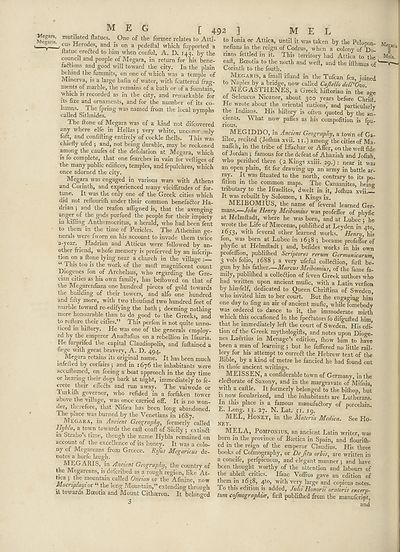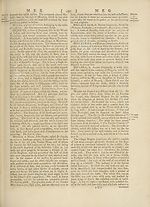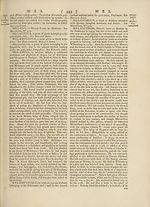Encyclopaedia Britannica, or, a Dictionary of arts, sciences, and miscellaneous literature : enlarged and improved. Illustrated with nearly six hundred engravings > Volume 13, MAT-MIC
(534) Page 492
Download files
Complete book:
Individual page:
Thumbnail gallery: Grid view | List view

MEG
Megara,
Megaris.
mutij-ated ftatues. One of the former relates to Atti-
cus Herodes, and is on a pedellal which fupported a
llatue erefted to him when conful, A. X). by the
council and people of Megara, in return for his bene-
faftions and good will toward the city. In the plain
behind the fummits, on one of which was a temple of
Minerva, is a large bafin of water, with fcattered frag¬
ments of marble, the remains of a bath or of a fountain,
which is recorded as in the city, and remarkable for
its fize and ornaments, and for the number of its co¬
lumns. . The fpring was named from the local nymphs
called Sithnides.
The ft one of Megara was of a kind not difcovered
any where elfe in Hellas j very white, uncommonly
foft, and confifting entirely of cockle fticlls. This was
chiefly ufed j and, not being durable, may be reckoned
among the caufes of the defolation at Megara, which
is fo complete,^ that one fearches in vain for veftiges of
the many public edifices, temples, and fepulchres, which
once adorned the city.
Megara was engaged in various wars with Athens
and Corinth, and experienced many viciflitudes of for¬
tune. It was the only one of the Greek cities which
did not reflourifh under their common benefadlor Ha¬
drian ; and the reafon afligned is, that the avenging
anger of the gods purfued the people for their impiety
in killing Anthemocritus, a herald, ivho had been fent
to them in the time of Pericles. The Athenian ge¬
nerals were fworn on his account to invade them twice
a-year. . Hadrian and Atticus were followed by an¬
other friend, whofe memory is preferved by an infcrip-
tion on a ftone lying near a church in the village :
“ / his to° ^ the work of the moft magnificent count
Diogenes fon of Archelaus, who regarding the Gre¬
cian cities as his own family, has beftowed on that of
the Megarenfians one hundred pieces of gold towards
the building of their towers, and alfo one hundred
and fifty more, with two thoufand two hundred feet of
marble toward re-edifying the bath ^ deeming nothing
more honourable than to do good to the Greeks, and
to reftore their cities.” I his perfon is not quite unno-
liced in hiftory. He was one of the generals employ¬
ed by the emperor Anaftafius on a rebellion in Ifauria.
He furpufed the capital Claudiopolis, and fuftained a
fiege with great bravery, A. D. 494.
Megara retains its original name. It has been much
infefted by corfairs 5 and in 1676 the inhabitants were
accuftomed, on feeing a boat approach in the day time
or hearing their dogs bark at night, immediately to fe-
t rete their eite£ls and run away. I he vaiwode or
Turkifh governor, who refided in a forfaken tower
above the village, was once carried off. It is no won¬
der, therefore, that Nifcea has been long abandoned.
The place was burned by the Venetians in 1687.
Megara, in Ancient Geography, formerly called
Hybla, a town towards the eaft coaft of Sicily 5 extimft
in Strabo s time, though the name Hybla remained on
account of the excellence of its honey. It was a colo¬
ny of Mcgareans from Greece. Rif us Megaricus de¬
notes a horfe laugh.
PvIEGARIS, in Ancient Geography, the country of
the Megareans, is deferibed as a rough region, like At¬
tica j the mountain called Oneian or the Afinine, now
Macrip/ayior “ the long Mountain,” extending throuo-h
it towards Eceotia and Mount Cithaeron. It belonged
3
[ 492 1
MEL
to Ionia or Attica, until it was taken by the Pelopon-
nefians in the reign of Codrus, when a colony of Do¬
rians fettled in it. This territory had Attica to the
eaft, Bceotia to the north and weft, and the ifthmus of'
Corinth to the fouth.
Megaris, a fmall ifiand in the Tufcan fca, joined
to Naples by a bridge, now called Cujlello dell'Ovo
M EGAS PHENES, a Greek hiftorian in the age
of Seleucus Nicanor, about 300 years before Chrift.
He wrote about the oriental nations, and particularly
the Indians. His hiftory is often quoted by the an¬
cients. W hat now paflts as his compofition is fpu-
rious. r
MEGIDDO, in Ancient Geography, a town of Ga¬
lilee, recited (Jolhua xvii. 11.) among the cities of Ma-
naffeh, in the tribe of Iffachar or After, on the weft fide
of Jordan 5 famous for the defeat of Ahaziah and Jofiah
who periftied there (2 Kings xxiii. 29.) : near it was
an open plain, fit for drawing up an army in battle ar-
ray. It was fituated to the north, contrary to its po-
fition in the common maps, i he Canaanites, being
tributary to the Ifraelites, dwelt in it, Jolhua xvii.~
It was rebuilt by Solomon, 1 Kings ix.
MEIBOMIUS, the name of feveral learned Ger¬
mans.—John Henry Meibomius was profeffor of phyfic
at Helm ft ad t, where he was born, and at Lubec : he
wrote the Life of Maecenas, publilhed at Leyden in 410,
1653, with feveral other learned works. Henry, his
fon, wras born at Lubec in 1638 } became profeffor of
phyfic at Helmftadt j and, befides works in his own
profeffion, publilhed Scriptores rerum Germanicarum
3 vols folio, 1688 J a very ufeful colle&ion, firft be¬
gun by his father—Marcus Meibomius, of the fame fa-
mily, publilhed a collection of feven Greek authors who
had written upon ancient mufic, with a Latin verfion
by himfelf, dedicated to Queen Chriftina of Sweden,
who invited him to her court. But Ihe engaging him
one day to ling an air of ancient mufic, while fomebody
was ordered to dance to it, the immoderate mirth
which this occafioned in the fpe&ators fo difgufted him
that he immediately left the court of Sweden. His edi¬
tion of the Greek mythologifts, and notes upon Dioge¬
nes Laertius in Menage’s edition, Ihow him to have
been a man of learning ; but he fuffered no little rail¬
lery for his attempt to correft the Hebrew text of the
Bible,^ by a. kind of metre he fancied he had found out
in thofe ancient writings.
MEISSEN, a confiderable town of Germany, in the
ele&orate of Saxony, and in the margravate of Mifnia,
with a caftle. It formerly belonged to the bilhop, but
is now fecularized, and the inhabitants are Lutherans.
In this place is a famous manufactory of porcelain.
E. Long. 13. 27. N. Lat. 51. 19.
MEL, Honey, in the Materia Medica. See Ho¬
ney.
MELA, Pomponius, an ancient Latin writer, was
born in the province of Bcetica in Spain, and flourilh-
ed in the reign of the emperor Claudius. His three
books of Cofmography, or Defitu orbis, are written in
a concife, perfpicuous, and elegant manner ; and have
been thought worthy of the attention and labours of
the ableft critics. Ifaac Volfius gave an edition of
them in 4X0, with very large and copious notes.
To this edition is added, Juln Honorn oratoris excerp-
tum cofmograpfiicc, firft publilhed from the manufeript,
and
Megar*
Mela.
Megara,
Megaris.
mutij-ated ftatues. One of the former relates to Atti-
cus Herodes, and is on a pedellal which fupported a
llatue erefted to him when conful, A. X). by the
council and people of Megara, in return for his bene-
faftions and good will toward the city. In the plain
behind the fummits, on one of which was a temple of
Minerva, is a large bafin of water, with fcattered frag¬
ments of marble, the remains of a bath or of a fountain,
which is recorded as in the city, and remarkable for
its fize and ornaments, and for the number of its co¬
lumns. . The fpring was named from the local nymphs
called Sithnides.
The ft one of Megara was of a kind not difcovered
any where elfe in Hellas j very white, uncommonly
foft, and confifting entirely of cockle fticlls. This was
chiefly ufed j and, not being durable, may be reckoned
among the caufes of the defolation at Megara, which
is fo complete,^ that one fearches in vain for veftiges of
the many public edifices, temples, and fepulchres, which
once adorned the city.
Megara was engaged in various wars with Athens
and Corinth, and experienced many viciflitudes of for¬
tune. It was the only one of the Greek cities which
did not reflourifh under their common benefadlor Ha¬
drian ; and the reafon afligned is, that the avenging
anger of the gods purfued the people for their impiety
in killing Anthemocritus, a herald, ivho had been fent
to them in the time of Pericles. The Athenian ge¬
nerals were fworn on his account to invade them twice
a-year. . Hadrian and Atticus were followed by an¬
other friend, whofe memory is preferved by an infcrip-
tion on a ftone lying near a church in the village :
“ / his to° ^ the work of the moft magnificent count
Diogenes fon of Archelaus, who regarding the Gre¬
cian cities as his own family, has beftowed on that of
the Megarenfians one hundred pieces of gold towards
the building of their towers, and alfo one hundred
and fifty more, with two thoufand two hundred feet of
marble toward re-edifying the bath ^ deeming nothing
more honourable than to do good to the Greeks, and
to reftore their cities.” I his perfon is not quite unno-
liced in hiftory. He was one of the generals employ¬
ed by the emperor Anaftafius on a rebellion in Ifauria.
He furpufed the capital Claudiopolis, and fuftained a
fiege with great bravery, A. D. 494.
Megara retains its original name. It has been much
infefted by corfairs 5 and in 1676 the inhabitants were
accuftomed, on feeing a boat approach in the day time
or hearing their dogs bark at night, immediately to fe-
t rete their eite£ls and run away. I he vaiwode or
Turkifh governor, who refided in a forfaken tower
above the village, was once carried off. It is no won¬
der, therefore, that Nifcea has been long abandoned.
The place was burned by the Venetians in 1687.
Megara, in Ancient Geography, formerly called
Hybla, a town towards the eaft coaft of Sicily 5 extimft
in Strabo s time, though the name Hybla remained on
account of the excellence of its honey. It was a colo¬
ny of Mcgareans from Greece. Rif us Megaricus de¬
notes a horfe laugh.
PvIEGARIS, in Ancient Geography, the country of
the Megareans, is deferibed as a rough region, like At¬
tica j the mountain called Oneian or the Afinine, now
Macrip/ayior “ the long Mountain,” extending throuo-h
it towards Eceotia and Mount Cithaeron. It belonged
3
[ 492 1
MEL
to Ionia or Attica, until it was taken by the Pelopon-
nefians in the reign of Codrus, when a colony of Do¬
rians fettled in it. This territory had Attica to the
eaft, Bceotia to the north and weft, and the ifthmus of'
Corinth to the fouth.
Megaris, a fmall ifiand in the Tufcan fca, joined
to Naples by a bridge, now called Cujlello dell'Ovo
M EGAS PHENES, a Greek hiftorian in the age
of Seleucus Nicanor, about 300 years before Chrift.
He wrote about the oriental nations, and particularly
the Indians. His hiftory is often quoted by the an¬
cients. W hat now paflts as his compofition is fpu-
rious. r
MEGIDDO, in Ancient Geography, a town of Ga¬
lilee, recited (Jolhua xvii. 11.) among the cities of Ma-
naffeh, in the tribe of Iffachar or After, on the weft fide
of Jordan 5 famous for the defeat of Ahaziah and Jofiah
who periftied there (2 Kings xxiii. 29.) : near it was
an open plain, fit for drawing up an army in battle ar-
ray. It was fituated to the north, contrary to its po-
fition in the common maps, i he Canaanites, being
tributary to the Ifraelites, dwelt in it, Jolhua xvii.~
It was rebuilt by Solomon, 1 Kings ix.
MEIBOMIUS, the name of feveral learned Ger¬
mans.—John Henry Meibomius was profeffor of phyfic
at Helm ft ad t, where he was born, and at Lubec : he
wrote the Life of Maecenas, publilhed at Leyden in 410,
1653, with feveral other learned works. Henry, his
fon, wras born at Lubec in 1638 } became profeffor of
phyfic at Helmftadt j and, befides works in his own
profeffion, publilhed Scriptores rerum Germanicarum
3 vols folio, 1688 J a very ufeful colle&ion, firft be¬
gun by his father—Marcus Meibomius, of the fame fa-
mily, publilhed a collection of feven Greek authors who
had written upon ancient mufic, with a Latin verfion
by himfelf, dedicated to Queen Chriftina of Sweden,
who invited him to her court. But Ihe engaging him
one day to ling an air of ancient mufic, while fomebody
was ordered to dance to it, the immoderate mirth
which this occafioned in the fpe&ators fo difgufted him
that he immediately left the court of Sweden. His edi¬
tion of the Greek mythologifts, and notes upon Dioge¬
nes Laertius in Menage’s edition, Ihow him to have
been a man of learning ; but he fuffered no little rail¬
lery for his attempt to correft the Hebrew text of the
Bible,^ by a. kind of metre he fancied he had found out
in thofe ancient writings.
MEISSEN, a confiderable town of Germany, in the
ele&orate of Saxony, and in the margravate of Mifnia,
with a caftle. It formerly belonged to the bilhop, but
is now fecularized, and the inhabitants are Lutherans.
In this place is a famous manufactory of porcelain.
E. Long. 13. 27. N. Lat. 51. 19.
MEL, Honey, in the Materia Medica. See Ho¬
ney.
MELA, Pomponius, an ancient Latin writer, was
born in the province of Bcetica in Spain, and flourilh-
ed in the reign of the emperor Claudius. His three
books of Cofmography, or Defitu orbis, are written in
a concife, perfpicuous, and elegant manner ; and have
been thought worthy of the attention and labours of
the ableft critics. Ifaac Volfius gave an edition of
them in 4X0, with very large and copious notes.
To this edition is added, Juln Honorn oratoris excerp-
tum cofmograpfiicc, firft publilhed from the manufeript,
and
Megar*
Mela.
Set display mode to:
![]() Universal Viewer |
Universal Viewer | ![]() Mirador |
Large image | Transcription
Mirador |
Large image | Transcription
Images and transcriptions on this page, including medium image downloads, may be used under the Creative Commons Attribution 4.0 International Licence unless otherwise stated. ![]()
| Permanent URL | https://digital.nls.uk/192668104 |
|---|
| Attribution and copyright: |
|
|---|
| Description | Ten editions of 'Encyclopaedia Britannica', issued from 1768-1903, in 231 volumes. Originally issued in 100 weekly parts (3 volumes) between 1768 and 1771 by publishers: Colin Macfarquhar and Andrew Bell (Edinburgh); editor: William Smellie: engraver: Andrew Bell. Expanded editions in the 19th century featured more volumes and contributions from leading experts in their fields. Managed and published in Edinburgh up to the 9th edition (25 volumes, from 1875-1889); the 10th edition (1902-1903) re-issued the 9th edition, with 11 supplementary volumes. |
|---|---|
| Additional NLS resources: |
|

